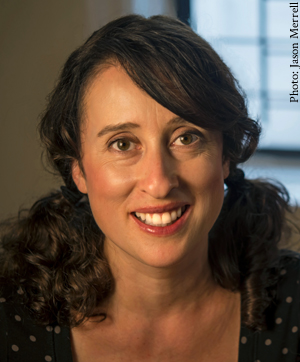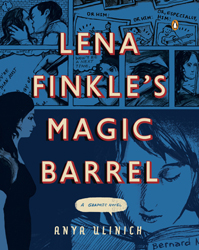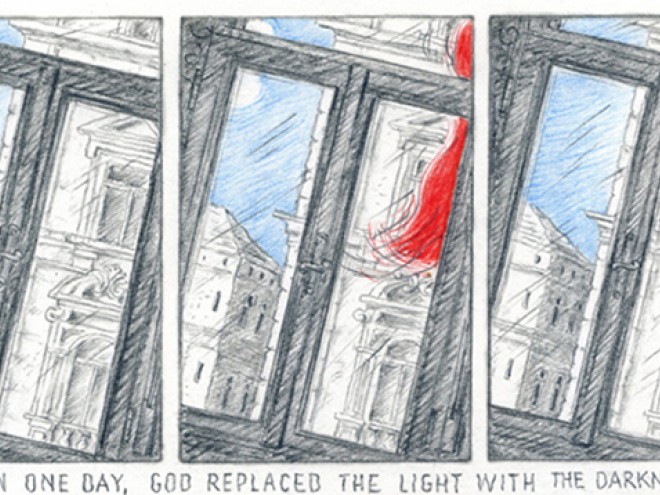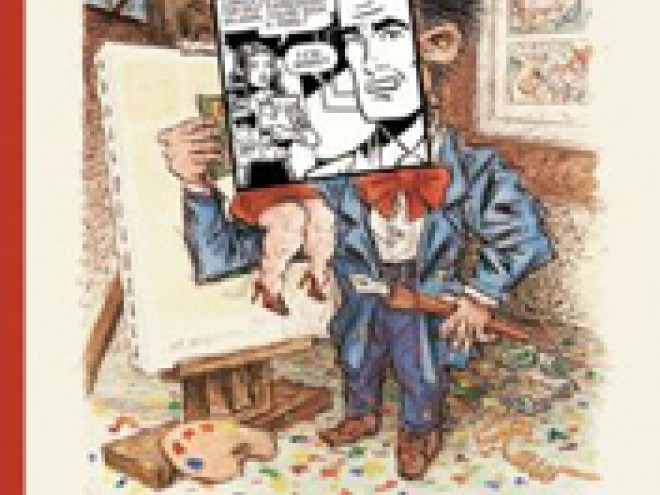Tahneer Oksman sat down recently with Anya Ulinich to discuss her first graphic novel, Lena Finkle’s Magic Barrel, published today by Penguin Books. Ulinich was a Finalist for the 2009 Sami Rohr Prize for Jewish Literature for her debut novel Petropolis.
 Tahneer Oksman: Is there a relationship between this book, Lena Finkle’s Magic Barrel, and your first, Petropolis?
Tahneer Oksman: Is there a relationship between this book, Lena Finkle’s Magic Barrel, and your first, Petropolis?
Anya Ulinich: Only inasmuch as the central characters are immigrants. Also, my characters are idiots — they’re not very insightful, so the stuff that happens to them ambushes them. They don’t arrive at an understanding of things naturally; it has to slap them in the face.
TO: Both of your books tie love stories, and particularly broken ones, to the immigrant experience. What do you think is the connection?
AU: As an immigrant, you have this sense of duty. It takes a long time for young people in general, but I think for immigrant people in particular, to figure out what it is that they really want and what it is that others have told them that they should want or that would make them happy. You have this path laid out for you. There are so many expectations. You don’t have the luxury to sit around and discover yourself.
Divorce is a little like immigration. It’s a huge change. There’s a physical move, but it’s also a question of how you define yourself now. It’s about identity as well.
TO: Is your graphic novel autobiographical?
AU: I would call Lena Finkle’s Magic Barrel a semi-autobiography, but it is fiction. I used my experiences to inform it, but it’s not the story exactly as it happened. Whatever I would tell in a memoir about heartbreak is here but it’s better because I wasn’t so hung up on specific people or events. My life is more boring than this. It would also be too painful for everyone to read my autobiography.
I argue against the whole distinction between fiction and non-fiction. I would rather those labels just go away and that we just call it a story.
TO: Your first book was all prose. What drove you to create a graphic novel this time around?
AU: I had a personal crisis — a major heartbreak — and I couldn’t write at all. So I started with doodles and drawings, and I found it was an easier way to tell stories. When I write, the writing sprawls and it never stops. If you draw a scene, and there are two people talking, you have to get everything into these bubbles and into the space of the page, or else you have to redraw the scene. Sometimes, I’m just too lazy. Drawing comics forces you, like poetry or a Facebook status or Twitter — to be focused on what you’re saying. This limitation really helped me tell the story.
TO: What was your process for drawing the book?
AU: When I started, everything was more cartoonish. And then I went back to drawing in a more realistic way. Once I was on a roll, it was really fun, almost like a break. Writing involves constant thinking, and drawing is fairly automatic for me. I love drawing faces and hands and landscapes, but not so much interiors. I can’t be bothered with details.
Sometimes a page would start as text and sometimes it would start as an image. People always ask me, “did you illustrate the book yourself?” People assume that you do the writing and you hire someone else to illustrate it. But “illustrate” isn’t the right word for it because illustration follows text; here the relationship is more complex. Sometimes there would be an image that would call for certain text.
TO: How did you decide on the style for your book?
AU: I used a more realistic style for the present and the past was drawn more in caricatures. I think memory is cartoonish. When we remember things, it’s usually major events or some detail really stands out, and we forget everything else. Memories are exaggerated, like cartoons. I thought that would distinguish the flashback from what happens in the present, just for narrative purposes.
 TO: Who are your major influences?
TO: Who are your major influences?
AU: I don’t have influences — I have inspirations. Reading Philip Roth always inspires and motivates me and makes me think, “I can do that.” He’s a motor mouth, like me. And I love Alison Bechdel’s Fun Home—she’s a cartoonist, with a perfect way of drawing. Every image is exquisite.
TO: Now that you’ve written a novel and a graphic novel, do you find that you prefer one medium over another?
AU: I’m a storyteller. I could just sit here and tell stories all day. The form is a vehicle more than anything. Sometimes one form just works better than another. As long as the story gets told, I’m happy.
Tahneer Oksman is Assistant Professor and Director of Academic Writing at Marymount Manhattan College. Her book on Jewish identity in contemporary women’s graphic memoirs is forthcoming from Columbia University Press.
Related Content:
- Meet Sami Rohr Prize Finalist…Anya Ulinich
- Reading List: Russian/Soviet Jewry
- Reading List: Graphic Novels and Comics from a Jewish Perspective
- A Bintel Brief: Love and Longing in Old New York by Liana Finck
Tahneer Oksman is a writer, teacher, and scholar. She is the author of “How Come Boys Get to Keep Their Noses?”: Women and Jewish American Identity in Contemporary Graphic Memoirs (Columbia University Press, 2016), and the co-editor of The Comics of Julie Doucet and Gabrielle Bell: A Place Inside Yourself (University Press of Mississippi, 2019), which won the 2020 Comics Studies Society (CSS) Prize for Best Edited Collection. She is also co-editor of a multi-disciplinary Special Issue of Shofar: an Interdisciplinary Journal of Jewish Studies, titled “What’s Jewish About Death?” (March 2021). For more of her writing, you can visit tahneeroksman.com.



